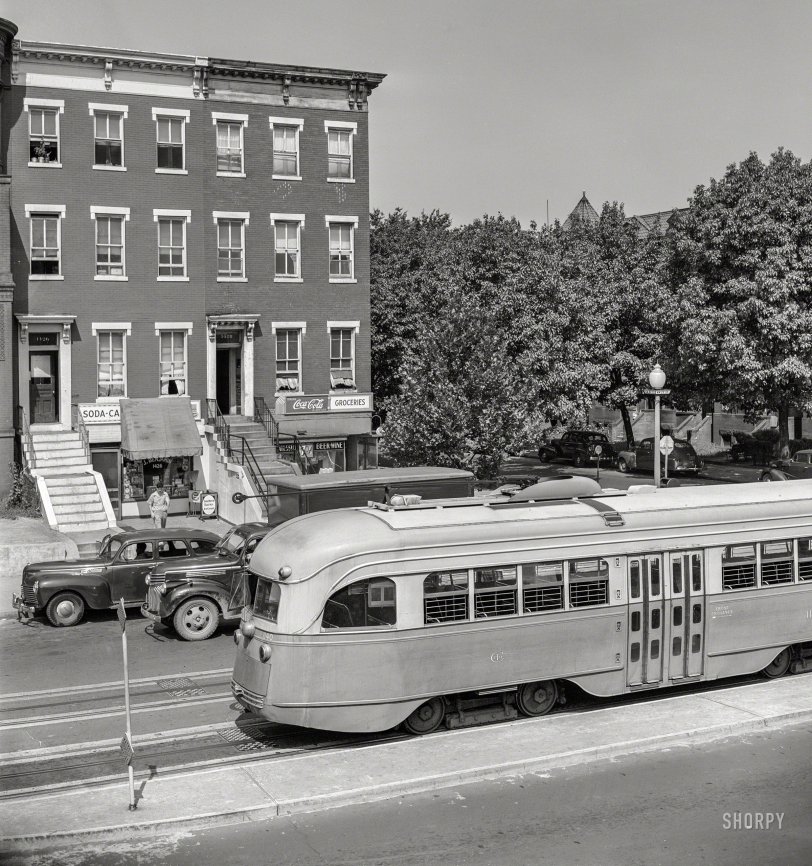


Framed or unframed, desk size to sofa size, printed by us in Arizona and Alabama since 2007. Explore now.
Shorpy is funded by you. Patreon contributors get an ad-free experience.
Learn more.

- Lofty addition
- In 1912
- Keenan Building
- Six years old
- Taken from the P.J. McArdle Roadway?
- It stood only 47 years
- Three track mind
- Incline to the right
- Reach for the sky, 1912 style
- No clean sweep
- Same Job Title, Same Face
- Sadly Lost
- Beautiful ...
- Where you get your kicks
- Aim High
- Pueblo Revival sisters
- Pueblo Neoclassicism
- Milk Man
- Regional dialect.
- Spielberg's inspiration
- Great Photo
- Loaf Story
- Do you still have the Rakes category?
- Could almost be a scene from the 1957 movie 'Hell Drivers'
- The Wages of Fear.
- Conspicuous by their absence
- Got Milk?
- All that aluminum
- No lefties
- Smoke 'em if you've got 'em
Print Emporium
Eleventh and P: 1942

August 1942. Washington, D.C. "Corner store on 11th Street N.W. which is patronized by Mrs. Ella Watson, a government charwoman." Medium format negative by Gordon Parks for the Office of War Information. View full size.
No overhead wires!
In DC, overhead wires were banned, so streetcars drew positive power from a conduit between the running rails. The current collecting device, mounted beneath the car, was called a plough (plow). For streetcar lines that also ran outside of the District, current was collected in the traditional way, i.e., trolley pole on the roof of the car to overhead wires; that's why this car also has the trolley pole. In either system, the running rails carried the return (neutral/ground/negative) back to the source of generation (powerhouse/substation).
Manhattan was another location where overhead trolley wires were banned; trolleys there also used the plow and center conduit for current collection. Many trolleys that only ran in Manhattan were not equipped with trolley poles at all, having only the plough.
The PCC car in the color photo is of later vintage than the earlier model PCC car in the Shorpy photo; note that the car in the B&W image lacks standee windows.
(By the way, it's "streetcar" in the South, "trolley" in the North. That's why Tennessee Williams's play is not titled "A Trolley Named Desire."
PCC cars, manufactured from the mid-1930s to the late 1940s-early 1950s, represented the pinnacle of street railway car development. They were smooth, quiet, and comfortable. The design has not been improved upon. You can still ride them in daily service in Philadelphia on the Route 15 (Girard Avenue) line of SEPTA, and also in San Francisco.
Speaking of Suspense
The block seen between the wheels is, indeed, one of the brakes on these cars. However, it is very hard (if not impossible) to determine from a photograph like this if this particular brake is applied. The blocks are known as track brakes, and are actually electromagnets which, when energized, are attracted to the rail. Thus, the force for the friction is not applied by the weight of the car, and also not through the wheels. Since these are electromagnets, they need to be close to the rail when not in use, so they are suspended on springs, less than an inch off the rail. They are very effective, and are normally used only in emergency or very slippery rail situations. They were controlled by a button, and were either off or on, with no ability to modulate the braking effort.
The cars had other brakes as well: dynamic using the motors as generators, and either air or electric (spring applied, electrically released) "parking" brakes.
Talk about suspense
To answer slr in tx, the sign is to get boarders to not block up the rear exit. Some cities allowed boarding from the back, others have waffled back and forth over time. In days gone by, conductors stationed by the back door at key stops would collect fares and allow boarding by the back door to speed things up.
Now, how did that streetcar get there? It is well parked with brake set (those blocks between the wheels) and its pole down. But where are the wires, either for the track its on or the adjoining track?
[The power supply is under the street. -Dave]
Dark Blue-Green & Gray
To accommodate the city's narrow streets and tighter corners the Washington, D.C. PCC streetcars were shorter than the ones used in the rest of the nation's cities. All the rest had 5 windows behind the rear exit where this one has 4.
The livery is shown here (later, when it was taken over by the owner of Trans-Caribbean Airlines it was given a bright turquoise/aqua/orange decor)
I'm in a state of suspense!
Does that coyly photographed public conveyance have a sign in front pointing out the rear entrance?
























On Shorpy:
Today’s Top 5